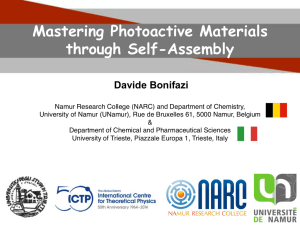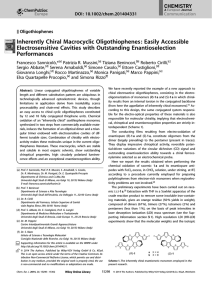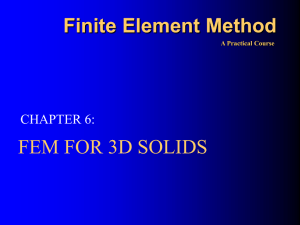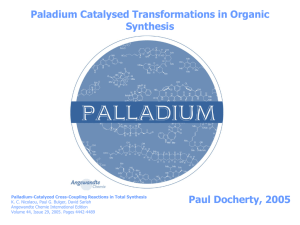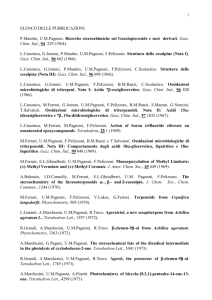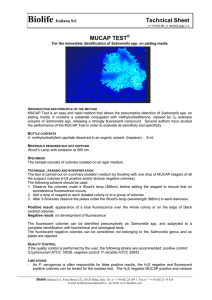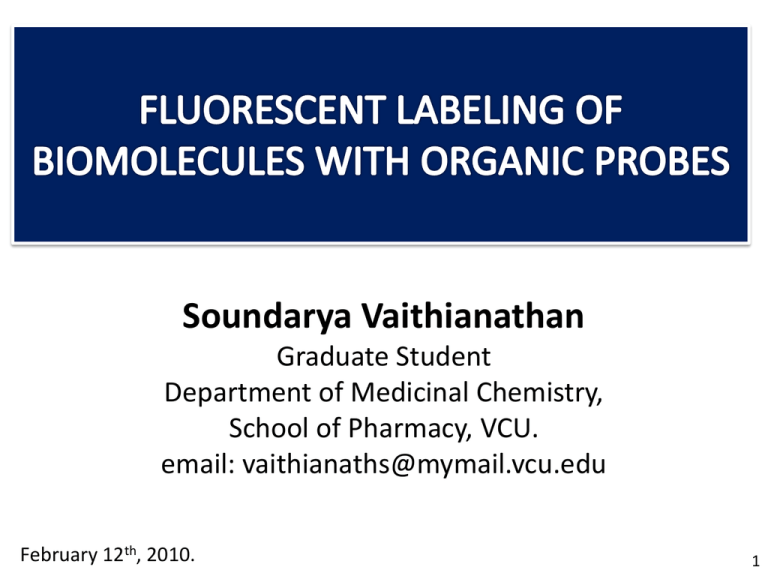
Soundarya Vaithianathan
Graduate Student
Department of Medicinal Chemistry,
School of Pharmacy, VCU.
email: vaithianaths@mymail.vcu.edu
February 12th, 2010.
1
WHAT ARE BIOMOLECULES ?
Biomolecules: Organic compounds that are involved in the
maintenance and metabolic processes of living organisms.
AMINO
ACIDS
DNA&RNA
BIO
MOLECULES
PEPTIDES
PROTEINS
http://www.biobasics.gc.ca/english/View.asp?mid=411&x=696
2
BIOMOLECULES
Implicated in various disease conditions such as those with
impaired amino acid metabolism.
E.g. Phenylketonuria
Peptide based pharmaceuticals, important class of therapeutic
agent.
Used to treat many diseases.
E.g. Interferon used in treat Multiple Sclerosis.
NEED TO BE DETECTED !!
Gatti, M.; Gioia, M. G.; Andreatta, P.; Pentassuglia, G. J. Pharm. Biomed. Anal. 2004, 35, 339-348.
Bennett, F. A.; Barlow, D. J.; Dodoo, A. N. O.; Hider, R. C.; Lansley, A. B.; Lawrence, M. J.;
Marriott, C.; Bansal, S. S. Anal. Biochem. 1999, 270, 15-23.
3
BIOMOLECULES
Problems in detection:
1. Structural similarity between
Analyte
Degradation product
Endogenous component
Impurities
2. Lack of selectivity
3. Sensitivity requirements not met
4. Lack of an effective method for detection in biological matrices
Bennett, F. A.; Barlow, D. J.; Dodoo, A. N. O.; Hider, R. C..; Lansley, A. B.; Lawrence, M. J.;
Marriott, C.; Bansal, S. S. Anal. Biochem. 1999, 270, 15-23.
Wang, W.; Li, H. Tetrahedron Lett. 2004, 45, 8479-8481.
4
LABELING OF BIOMOLECULES
LABELING
COMPOUNDS
WITH
FLUORESCENCE
INORGANIC
RADIOACTIVE
COMPOUNDS
ORGANIC
Goncalves, S. Chem Rev. 2009, 109, 190-212.
Toyo’oka, T. Anal. Chim. Acta 2002, 465, 111.
5
FLUORESCENCE
ν
ν
Absorption
Fluorescence
6
ORGANIC FLUOROPHORES
Organic Fluorophore: component of a molecule which causes it to
be fluorescent
Form covalent or non covalent linkage with sample to be analyzed
Production of conjugates or complexes
Fluorescence from short to very long wavelength
Detection of biomolecules
Goncalves, S. Chem Rev. 2009, 109, 190-212.
7
ELECTROMAGNETIC SPECTRUM
VISIBLE
LIGHT
INFRARED
UV
X-RAY
MICROWAVE
nan
RADIO
GAMMA
Wavelength: 5,000,000,000
1,000
500
250
Energy: 0.000000248
0.124
2.48
4.96
0.5
0.0005 nanometers
2480 2,480,000 electron volts
1cm = 10,000,000 nm
Image taken from:
http://lot.astro.utoronto.ca/images/spectrum.png
8
CLASSIFICATION
Organic Labels
Emission up to 500 nm
1.
2.
3.
4.
OXYGEN heterocycle
SULFUR heterocycle
NITROGEN heterocycle
NAPHTHALENE
fluorophores
Goncalves, S. Chem Rev. 2009, 109, 190-212
Emission beyond 500 nm
1.
2.
3.
4.
5.
Fluoresceins
Rhodamines
BODIPY fluorophores
Squarines
Cyanines
9
CLASSIFICATION
Organic Labels
Emission up to 500 nm
1.
2.
3.
4.
OXYGEN heterocycle
SULFUR heterocycle
NITROGEN heterocycle
NAPHTHALENE
fluorophores
Goncalves, S. Chem Rev. 2009, 109, 190-212
Emission beyond 500 nm
1.
2.
3.
4.
5.
Fluoresceins
Rhodamines
BODIPY fluorophores
Squarines
Cyanines
10
OXYGEN HETEROCYCLE
Fluorescent Quantum Yield φF =
Photons emitted
Photons absorbed
φF : 0.0 to 1.0
Molar absorptivity ε : measure of how strongly a chemical
species absorbs
Units: M-1 cm-1
11
OXYGEN HETEROCYCLE
Two main classes of compounds:
1. COUMARINS :
2. FURANS :
a) BENZOFURAN
b) NAPHTHOFURAN
Piloto, A.M.; Fonseca, A.S.C.; Costa,S.P.G.; Goncalves, M.S.T. Tetrahedron 2006, 62,9258-9267.
12
Gikas, E.; Parissi-Poulou, M.; Kazanis, M.; Vavagianis, A. Anal. Chim. Acta 2003, 57,259.
COUMARINS
1. COUMARINS
Characteristics:
λ ex: 345 nm
λ em: 440 nm
ɸF: 0.52
ε : 10,900 M-1 cm-1
Wang, W.; Li, H. Tetrahedron Lett. 2004, 45, 8479-8481.
Bennett, F. A,; Barlow, D. J.; Dodoo, A. N. O.; Hider, R. C.; Lansley, A. B.; Lawrence, M. J.; Marriott,
13
C.; Bansal, S. S. Anal. Biochem. 1999, 270, 15-23.
SYNTHESIS OF Dmca
91%
6,7-Dimethoxy-4-methylcoumarin
77%
Z/E : 95/5
Buchi, G.; Foulkes, D. M.; Kurono, M.; Mitchell, G. F.; Schneider, R. S. J. Am. Chem. Soc. 1967, 89,
6745-6753 .
14
Wadsworth Jr., W.S.; Emmons, W.D. J. Am. Chem. Soc., 1961, 83, 1733.
SYNTHESIS OF Dmca
S
96%
95% ee
1,2-bis-((2R,5R)-2,5- diethylphospholano)benzene(cyclooctadiene)rhodium(I) trifluoromethane sulfonate
High Yield : 96%
Lactone not reduced
Wang, W.; Li, H. Tetrahedron Lett. 2004, 45, 8479-8481.
15
ADVANTAGES OF Dmca
Coumarin side chain is fluorescent.
Selective determination.
High detection sensitivity.
Easy incorporation into peptide sequence.
Treatment with HBr/TFA does not alter stability.
Bennett, F. A,; Barlow, D. J.; Dodoo, A. N. O.; Hider, R. C.; Lansley, A. B.; Lawrence, M. J.; Marriott,
16
C.; Bansal, S. S. Anal. Biochem. 1999, 270, 15-23.
OXYGEN HETEROCYCLE
Two main classes of compounds:
1. COUMARINS :
2. FURANS :
a) BENZOFURAN
b) NAPHTHOFURAN
Piloto, A.M.; Fonseca, A.S.C.; Costa,S.P.G.; Goncalves, M.S.T. Tetrahedron 2006, 62,9258-9267.
17
Gikas, E.; Parissi-Poulou, M.; Kazanis, M.; Vavagianis, A. Anal. Chim. Acta 2003, 57,259.
BENZOFURANS & NAPHTHOFURANS
Polycyclic Oxygen Heterocycles
Fluorescent pre column derivatization agent in HPLC analysis of
amino acids
Piloto, A.M.; Costa, S. P. G.; Goncalves, M. S. T. Tetrahedron Lett. 2005, 46, 4757.
Piloto, A.M.; Fonseca, A.S.C.; Costa,S.P.G.; Goncalves, M.S.T. Tetrahedron 2006, 62,9258-9267. 18
SYNTHESIS OF BENZOFURAN
92%
Piloto, A.M.; Fonseca, A.S.C.; Costa,S.P.G.; Goncalves, M.S.T. Tetrahedron 2006, 62,9258-9267. 19
SYNTHESIS OF NAPHTHOFURAN
Piloto, A.M.; Costa, S. P. G.; Goncalves, M. S. T. Tetrahedron Lett. 2005, 46, 4757-4760.
20
APPLICATION OF BENZOFURAN
Piloto, A.M.; Fonseca, A.S.C.; Costa,S.P.G.; Goncalves, M.S.T. Tetrahedron 2006, 62,9258-9267. 21
APPLICATION OF NAPHTHOFURAN
Piloto, A.M.; Costa, S. P. G.; Goncalves, M. S. T. Tetrahedron Lett. 2005, 46, 4757-4760.
22
NAPHTHOFURAN IS BETTER
FLUOROPHORE
STRUCTURE
λex
λem
φF
298
349
0.20
285
315
0.020
(nm)
(nm)
NAPHTHOFURAN
( R= OCH3)
BENZOFURAN
Piloto, A.M.; Fonseca, A.S.C.; Costa,S.P.G.; Goncalves, M.S.T. Tetrahedron 2006, 62,9258-9267. 23
NAPHTHOFURAN IS BETTER
FLUOROPHORE
STRUCTURE
λex
λem
(nm)
(nm)
298
349
0.32
288
315
0.064
φF
NAPHTHOFURAN
LINKED TO
PHENYLALANINE
BENZOFURAN
LINKED TO
PHENYLALANINE
Piloto, A.M.; Fonseca, A.S.C.; Costa,S.P.G.; Goncalves, M.S.T. Tetrahedron 2006, 62,9258-9267. 24
NAPHTHOFURAN IS BETTER
FLUOROPHORE
STRUCTURE
λex
λem
(nm)
(nm)
298
346
0.37
288
315
0.070
φF
NAPHTHOFURAN
LINKED TO VALINE
BENZOFURAN
LINKED TO VALINE
Piloto, A.M.; Fonseca, A.S.C.; Costa,S.P.G.; Goncalves, M.S.T. Tetrahedron 2006, 62,9258-9267. 25
EFFECT OF SUBSTITUENTS
1.
ɸF
λex
λem
0.20
298
341
0.062
301
349
0.076
293
340
R = OCH3
2.
3.
R = OH
R=H
Piloto, A.M.; Fonseca, A.S.C.; Costa,S.P.G.; Goncalves, M.S.T. Tetrahedron 2006, 62,9258-9267. 26
CLASSIFICATION
Organic Labels
Emission up to 500 nm
1.
2.
3.
4.
OXYGEN heterocycle
SULFUR heterocycle
NITROGEN heterocycle
NAPHTHALENE
fluorophores
Goncalves, S. Chem Rev. 2009, 109, 190-212
Emission beyond 500 nm
1.
2.
3.
4.
5.
Fluoresceins
Rhodamines
BODIPY fluorophores
Squarines
Cyanines
27
SULFUR HETEROCYCLE
Oligothiophenes are sulfur containing compounds
Intrinsic Fluorescence
E.g. Terthiophene
λex = 356 nm
λex = 441 nm
5-(2-Hydroxyethyl)-2,2’:5’,2”-terthiophene
Used as a fluorescent tag for oligonucleotides via phosphoramidite
coupling
Capobianco, M.L.; Naldi, M.; Zambianchi, M.; Barbarella, G. Tetrahedron Lett. 2005, 46,
8181-8184.
28
PHOSPHORAMIDITE OF TERTHIOPHENE
Capobianco, M.L.; Naldi, M.; Zambianchi, M.; Barbarella, G. Tetrahedron Lett. 2005, 46,
8181-8184.
29
TERTHIOPHENE – T4 CONJUGATE
λex = 360nm
λex = 454 nm
Probes for detecting DNA & RNA
Capobianco, M.L.; Naldi, M.; Zambianchi, M.; Barbarella, G. Tetrahedron Lett. 2005, 46,
8181-8184.
30
APPLICATION
Oligothiophene N-succinimidyl ester
Conjugated to oligonucleotides with free –NH2 terminal at 3’
position
FRET (Fluorescence Resonance Energy Transfer) experiments are
carried out
Barbarella, G.; Zambianchi, M,; Sotgiu, G.; Ventola, A.;Galeotti, M.;Gigli, G.;Cazzato,
A.;Capobianco, M.L. J.Non-Cryst. Solids 2006, 352,2465-2467.
31
FRET – MOLECULAR BEACON
Barbarella, G.; Zambianchi, M,; Sotgiu, G.; Ventola, A.;Galeotti, M.;Gigli, G.;Cazzato,
A.;Capobianco, M.L. J.Non-Cryst. Solids 2006, 352,2465-2467.
32
CLASSIFICATION
Organic Labels
Emission up to 500 nm
1.
2.
3.
4.
OXYGEN heterocycle
SULFUR heterocycle
NITROGEN heterocycle
NAPHTHALENE
fluorophores
Goncalves, S. Chem Rev. 2009, 109, 190-212
Emission beyond 500 nm
1.
2.
3.
4.
5.
Fluoresceins
Rhodamines
BODIPY fluorophores
Squarines
Cyanines
33
NITROGEN HETEROCYCLE
Used as pre or post column chemical derivatization reagent.
Efficient tool for analysis of amino acid.
Gatti, M.; Gioia, M. G.; Andreatta, P.; Pentassuglia, G. J. Pharm. Biomed. Anal. 2004, 35, 339-348.
Dafau, I.; Mazerguil, H. Tetrahedron Lett. 2000, 41, 6063-6066.
34
PHANQUINONES
4,7-Phenanthroline-5,6-dione
Produces highly fluorescent iminoquinols separated by reverse
phase HPLC.
λ ex : 400 nm
λ em :460 nm
Gatti, M.; Gioia, M. G.; Andreatta, P.; Pentassuglia, G. J. Pharm. Biomed. Anal. 2004, 35, 339-348.
35
Gatti, R.;Gioia, M.G.; Di Pietra, A.M. Anal. Chim. Acta 2002, 474,11-20.
BENZOOXADIAZOLE
λ ex : 470 nm
λ em: 530 nm
Uchiyama, S.; Takehira, K.; Kohtani, S.; Imai, K.; Nagasaki, R.; Tobita, S.; Santa, T. Org.
Biomol.
2003,H.1,Tetrahedron
1067-1072. Lett. 2000, 41, 6063-6066.
Dafau,
I.;Chem.
Mazerguil,
36
INTRINSIC PROBES
Tryptophan , tyrosine and phenylalanine.
Disadvantages of Tryptophan (W):
Quenched by neighboring protonated acidic groups.
More than 1 residue Interpretation of spectral changes
is difficult.
λ ex : 280 nm
λ em :348 nm
Chen, Y.; Gai, F.; Petrich, J. W. J. Phys. Chem. 1994, 98, 2203
Fillipis, V.; Boni, S.; Dea, E.; Dalzoppo, D.; Grandi, C.; Fontana, A. Protein Sci. 2004,13, 14891502.
37
NON-CODED ANALOG
Non-coded analogs used instead of Tryptophan
Tryptophan
λ ex : 280 nm
λ ex : 290 nm
λ em :348 nm
λ em :394 nm
Chen, Y.; Gai, F.; Petrich, J. W. J. Phys. Chem. 1994, 98, 2203
Fillipis, V.; Boni, S.; Dea, E.; Dalzoppo, D.; Grandi, C.; Fontana, A. Protein Sci. 2004,13, 14891502.
38
HIRUDIN
To investigate disulfide-coupled folding of Hirudin fragment 1- 47:
Anticoagulant : potent inhibitor of thrombin
N terminal: 1-47 amino acids; C terminal: 48-64 amino acids
3 disulfide linkages (Cys6-Cys14, Cys16-Cys28, Cys22-Cys37)
Image: http://en.wikipedia.org/wiki/File:Hirudin in complex with thrombin.png
Fillips, V.; Russo, I.; Vindigni, A.; DiCera, E.; Salmaso, S.; Fontana, A.; Protein Sci. 1999, 8,
2213-2217.
39
CHANGES IN HIRUDIN
1
Tyrosine
Tyrosine
3
13
47
N – Terminal of Hirudin
Tryptophan
Tyrosine
3
13
1
N – Terminal of Hirudin
7-Azatryptophan
1
3
47
Y3W
Tyrosine
13
N – Terminal of Hirudin
47
Y3AW
Fillips, V.; Boni, S.; Dea, E.; Dalzoppo, D.; Grandi, C.; Fontana, A. Protein Sci. 2004, 13, 14891502.
40
UV & FLUORESCENCE SPECTRUM
Absorptivity M-1 cm-1 x 10-3
UV-absorption spectrum:
Tryptophan (W)
7-Azatryptophan (AW)
Fluorescence spectra:
Tyrosine (Y)
Red shift in absorption of
AW compared to W
Wavelength (nm)
Fillips, V.; Boni, S.; Dea, E.; Dalzoppo, D.; Grandi, C.; Fontana, A. Protein Sci. 2004, 13, 14891502.
41
FLUOROSENCE EMISSION OF Y3AW
7-Azatryptophan
1
Tyrosine
3
13
47
N – Terminal of Hirudin
Y3AW
Relative Fluorosence
Reduced Form:
Tyr 13305 nm
AW 3 397 nm
Oxidized Form:
Tyr band disappears
AW 3 390 nm
Reduced form solid line
Disulfide oxidized dashed line
Wavelength (nm)
Fillips, V.; Boni, S.; Dea, E.; Dalzoppo, D.; Grandi, C.; Fontana, A. Protein Sci. 2004, 13, 14891502.
42
FLUOROSENCE EMISSION OF Y3W
Tryptophan
Tyrosine
3
13
1
47
N – Terminal of Hirudin
Y3W
Relative Fluorosence
Reduced Form:
Trp 3 355 nm
Tyr 13 303 nm
Oxidized Form:
Trp 3 350 nm
Wavelength (nm)
Reduced form solid line
Disulfide oxidized dashed line
Fillips, V.; Boni, S.; Dea, E.; Dalzoppo, D.; Grandi, C.; Fontana, A. Protein Sci. 2004, 13, 14891502.
43
CLASSIFICATION
Organic Labels
Emission up to 500 nm
1.
2.
3.
4.
OXYGEN heterocycle
SULFUR heterocycle
NITROGEN heterocycle
NAPHTHALENE
fluorophores
Goncalves, S. Chem Rev. 2009, 109, 190-212.
Emission beyond 500 nm
1.
2.
3.
4.
5.
Fluoresceins
Rhodamines
BODIPY fluorophores
Squarines
Cyanines
44
NAPHTHALENE FLUOROPHORES
Extensively used as labels for amino acids, peptides and
proteins.
Dansyl chloride
Non fluorescent.
Pre column derivatization agent for detection of amino acids in
biological samples.
Kang, X.; Xiao, J.; Huang, X.; Gu, Z. Cli. Chim. Acta 2006, 366, 352-356.
45
“IN-SYNTHESIS” LABELING OF PEPTIDES
Peptides synthesized by solid-phase method
Coupling of Boc-Lys( Fmoc )-COOH to the growing peptide chain
Chersi, A.; Modugno, F.; Rosano, L. Biochim Biophys. Acta 1997, 1336, 83-88.
46
“IN-SYNTHESIS” LABELING OF PEPTIDES
8ml of 20% solution of piperidine in DMF cleave Fmoc group
20 fold molar excess of Dansyl Chloride in solvent mixture
( Sodium carbonate +ethanol +DMF +acetone )
Chersi, A.; Modugno, F.; Rosano, L. Biochim Biophys. Acta 1997, 1336, 83-88.
47
“IN-SYNTHESIS” LABELING OF PEPTIDES
45% Trifluoroacetic Acid Cleaves Boc New coupling step
Treatment of resin particles with TFMSA
Filtered through Gelman Acrodisc and precipitated with cold ether
Advantages:
Extensive modification of proteins avoided.
Peptides are better fluorescent labeled entities.
Alpha amino group is spared.
Chersi, A.; Modugno, F.; Rosano, L. Biochim Biophys. Acta 1997, 1336, 83-88.
48
PRODAN
6-Propionyl-2-(dimethylamino)naphthalene
Environmentally sensitive fluorophore:
Red shift with increasing polarity of solvent.
Cyclohexane: λ ex = 342 nm ; λ em = 401 nm
Water: λ ex = 364 nm ; λ em = 531 nm
Electron donor group
Electron acceptor group
Maximum effects 2 groups far apart
Weber, G.; Farris, F. J. J. Biochem. 1979, 18, 3075-3078.
Nitz, M.; Mezo, A. R.; Ali, M. H.; Imperiali, B. Chem. Commun. 2002, 1912-1913.
49
DANA
PROBLEM WITH PRODAN:
Various degrees of freedom and distances develop on labeling
amino acids reduces environment sensitivity.
DANA was synthesized
6-(2-Dimethylaminonaphthoyl)alanine
Cohen, B.E.; McAnaney, T.B.; Park, E.S.; Jan, Y.N.; Boxer, S.G.; Jan, L.Y. Science 2002, 296, 17001703.
50
Nitz, M.; Mezo, A. R.; Ali, M. H.; Imperiali, B. Chem. Commun. 2002, 1912-1913.
APPLICATION OF DANA
To monitor phosphorylation dependent binding of peptides to
proteins:
AcHN-Arg-Leu-ɸ-Arg-X-Leu-Pro-Ala-CONH2
ɸ = DANA
Rothman, D. M.; Vazquez, M. E.; Vogel, E. M.; Imperali, B. Org. Lett. 2002, 4, 2865-2868.
Vazquez, M. E.; Nitz, M.; Stehn, J.; Yaffee, M. B.; Imperiali, B. J. Am. Chem. Soc.2003, 125,
10150.
51
APPLICATION OF DANA
X = SERINE
1. Unmodified serine
2. Phosphoserine
3. Caged phosphoserine
14-3-3 Proteins:
Highly conserved family of proteins.
Essential intermediates in cell cycle regulation.
Phosphorylation dependent protein-protein interaction.
Rothman, D. M.; Vazquez, M. E.; Vogel, E. M.; Imperali, B. Org. Lett. 2002, 4, 2865-2868.
Vazquez, M. E.; Nitz, M.; Stehn, J.; Yaffee, M. B.; Imperiali, B. J. Am. Chem. Soc.2003, 125,
10150.
52
PHOSPHORYLATION DEPENDENT BINDING
hν
λ em1 = 522 nm
14-3-3
λ em2 = 501 nm
14-3-3
Rothman, D. M.; Vazquez, M. E.; Vogel, E. M.; Imperiali, B. Org. Lett. 2002, 4, 2865-2868.
Vazquez, M. E.; Nitz, M.; Stehn, J.; Yaffee, M. B.; Imperiali, B. J. Am. Chem. Soc.2003, 125,
10150.
53
NDA
Naphthalene-2,3-dicarboxaldehyde:
Non fluorescent.
Fluorescent derivatizing agent .
Used for detection of primary amines in HPLC.
Yang , Q.; Zhang, X-L.; Ma, M.; Huang, K-J.; Zhang, J-X.; Ni, W-Z.; Fang, C-X.; Zheng, C-Y.
J.Chromatogr. A 2007, 1146,23-31.
54
DETECTION OF DEGRADATION PRODUCTS OF MELANIN
Melanin:
Color of skin, eye and hair in mammals is due to melanin.
Uses:
Powerful antioxidant.
Photo protective pigment.
Free radical scavengers.
Yang , Q.; Zhang, X-L.; Ma, M.; Huang, K-J.; Zhang, J-X.; Ni, W-Z.; Fang, C-X.; Zheng, C-Y.
J.Chromatogr. A 2007, 1146,23-31.
55
DEGRADATION PRODUCTS OF PHEOMELANIN
2 main degradation products
3-Amino-4-hydroxyphenylalanine
hydroxyphenylalanine
4-Amino-3-
Melanoma: melanocytes become malignant.
Skin: cutaneous melanoma.
Eyes: ocular melanoma.
Yang , Q.; Zhang, X-L.; Ma, M.; Huang, K-J.; Zhang, J-X.; Ni, W-Z.; Fang, C-X.; Zheng, C-Y.
J.Chromatogr. A 2007, 1146, 23-31.
56
DETECTION
λ ex = 420 nm
λ em = 490 nm
Yang , Q.; Zhang, X-L.; Ma, M.; Huang, K-J.; Zhang, J-X.; Ni, W-Z.; Fang, C-X.; Zheng, C-Y.
J.Chromatogr. A 2007, 1146,23-31.
57
SUMMARY
Biomolecules important mediators of various physiological
processes
Number of short comings in the methods to detect biomolecules,
fluorescent labels were used.
Compounds with Oxygen heterocycle, Sulfur heterocycle, Nitrogen
heterocycle and Naphthalene were used as organic fluorescent labels.
Fluorophore + Biomolecules = Fluorescent derivative
Use:
Pre-column derivatization agent
Metabolic products
Degradation products
58
ACKNOWLEDGEMENTS
Dr. Yan Zhang
The Zhang Group
Department of Medicinal Chemistry, School of Pharmacy,
Virginia Commonwealth University.
59

